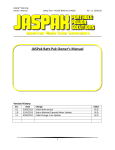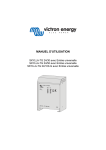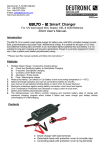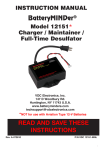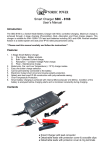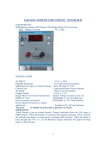Download 12248 ODY - BatteryMINDers
Transcript
BatteryMINDer© Model 12248-A-ODY INSTRUCTION MANUAL BatteryMINDer® Model 12248-A-ODY Odyssey-Specific Charger / Maintainer / De-Sulfator with “At-The-Battery” Temperature Sensor 9LL=JQ'#(=J ¸ Charger / Maintainer / Full Time De-Sulfator 12-Volt @ 8 Amp Model 12248-A-ODY ODYSSEY-SPECIFIC 8A For Lead-Acid Batteries ONLY VDC Electronics, Inc. 800-379-5579 (ET) www.batteryminders.com Green = Power ON ERROR: Red = Polarity Reversed / Battery = less than 3-Volts* Red (Blinking) = Battery not fully charged charger in float-maintenance mode* ODYSSEY BATTERY ONLY Battery Condition Indication Power On & Battery Connected Before Start Charge: Green = OK - Accepted Yellow = Weak / Sulphated / Deep Discharge* After Charge: Green = Good Yellow = Sulphated / Weak* PRESS Stop Restart Charge - Float Green (solid) = Charging Green (blinking) = Float (maintenance) *See Instruction Manual Hold for 5 sec. for full reset For use with all 600, 900* and 1200* Series Odyssey Sealed 12-Volt Batteries or (2) 6-Volt Series Connected *Maintainer only VDC Electronics, Inc. 147 D Woodbury Rd. Huntington, NY 11743 www.batteryminders.com [email protected] READ AND SAVE THESE INSTRUCTIONS Rev. D-050509 D-050509 Page P/NVDC12248-A-ODY-MNL VDC12248-A-ODY-MNL P/N BatteryMINDer© Model 12248-A-ODY TABLE OF CONTENTS Safety Instructions........................................................... 3 - 7 Preparing To Charge...................................................... 5 Charger Location......................................................... 5 DC Connection Precautions............................................. 6 Qualifying Your Battery....................................................... 8 Testing A Sealed, AGM-Odyssey Battery................................... 10 Unit With Call-Outs............................................................ 12 Simplified Operating Instructions........................................... 13 LED Indicator Functions...................................................... 14 Detailed Operation Instructions............................................. 16 Maintaining Multiple Batteries............................................. 22 Battery Configurations........................................................ 23 Troubleshooting................................................................ 24 Detailed Specifications....................................................... 26 Charging Profile............................................................... 31 For Repair or Replacement................................................... 32 Notes............................................................................ 33 Guarantee And Warranty...................................................... 34 Rev. D-050509 Page P/N VDC12248-A-ODY-MNL BatteryMINDer© Model 12248-A-ODY WARNING Underwriters Laboratories (UL) REQUIRED SAFETY INSTRUCTIONS TO REDUCE THE RISK OF FIRE, ELECTRIC SHOCK, OR INJURY TO PERSON, OBSERVE THE FOLLOWING: 1. Do not expose charger to rain or snow. It is designed to operate ONLY INDOORS. 2. USE of any attachment not specifically recommended by the battery charger manufacturer for use with this exact model of charger may result in risk of fire & electric shock or injury to person. 3. An extension cord should not be used, unless absolutely necessary. Use of an improper extension cord could result in fire or electric shock. If extension cord must be used be sure: a. Pins on plug of extension cord are the same number, size, & shape of plug on charger b. Extension cord is properly wired and in good condition. c. Wire size is enough for AC ampere of charger as specified below: Length of cord, feet (meters) 25 (7.6), 60 (15.2), 100 (30.5), 150 (45.6) AWG Size #18. 4. Do not use charger if it received a sharp blow, been dropped, or damaged. 5. Charger contains no serviceable parts. If it fails for any reason, return to the address shown within for a free replacement under warranty. 6. To reduce risk of electric shock, unplug charger from outlet before attempting any cleaning. 7. WARNING - RISK OF EXPLOSIVE GASES. WHENEVER YOU WORK NEAR A LEAD ACID BATTERY IT IS DANGEROUS. BATTERIES GENERATE EXPLOSIVE GASES DURING NORMAL BATTERY OPERATION. FOR THIS REASON, IT IS OF UTMOST IMPORTANCE THAT EACH TIME BEFORE USING YOUR CHARGER, YOU MUST READ THIS MANUAL AND FOLLOW THE INSTRUCTIONS EXACTLY. Rev. D-050509 Page P/N VDC12248-A-ODY-MNL BatteryMINDer© Model 12248-A-ODY To reduce risk of battery explosion, follow these instructions and those published by the battery manufacturer and the manufacturer of any equipment you plan to use in the vicinity of the battery. Review cautionary markings on the products and the engine. 8. PERSONAL PRECAUTIONS when working with or near a lead acid battery: a. Someone should be able to hear your voice or close enough to aid you when working near a lead acid battery. b. Have fresh water and soap nearby case battery acid contact skin, clothing, or eyes. Wear complete eye protection and clothing protection. Avoid touching eyes while working near battery. c. If battery acid does contact skin or clothing, wash immediately with soap and water. If acid entered the eye, immediately flood the eye with running water for at least 10 minutes and get help immediately. d. NEVER smoke or allow a spark of flame near battery or engine. e. Be extra cautious to reduce risk of dropping a metal tool or auto part onto battery. It might spark or short circuit battery or other electrical part that may cause an explosion. f. Remove personal metal items such as rings, bracelets, necklaces, and watches when working with a lead acid battery. A lead acid battery can produce a short circuit current high enough to weld a ring or the like to metal, causing a severe burn. g. Charger is designed to be used for recharging lead acid batteries ONLY. Never use it to power a low voltage electrical system, or for attempting to recharge dry cell batteries that are commonly used in house holds. These batteries may explode and cause injury to persons and damage property Rev. D-050509 Page P/N VDC12248-A-ODY-MNL BatteryMINDer© Model 12248-A-ODY NEVER CHARGE A FROZEN BATTERY OR ONE AT A TEMPERATURE ABOVE 123° F. PREPARING TO CHARGE a. If necessary to remove battery from equipment to charge. Always remove ground terminal first. Turn off all accessories in the vehicle, so as not to cause an arc. b. Be sure area around battery is well ventilated while battery is being charged. Force gas vapors away by using a piece of non-metallic material as a fan. c. Clean battery terminals. Be careful to keep corrosion from contacting eyes. d. Add distilled water to each cell until battery acid reaches level specified by the manufacturer. This helps Purge excessive gas from cells. Do not overfill. For a battery without caps, follow manufacturer’s recharging instructions. e. Study all battery manufacturer’s specific instructions such as removing cell caps while charging and recommended charge rates. f. Determine condition of battery, by referring to instructions herein, before ever attempting to charge or desulphate any / all batteries. CHARGER LOCATION a. Make sure charger is as far away from battery as output cables permit. b. Never place charger directly above battery being charged; gases from battery will corrode and damage charger. c. Never allow battery acid to drip on charger when reading specific gravity or filling. d. Do not operate charger in a closed-in area or restrict ventilation in any way. e. Do not set battery on top of charger. Rev. D-050509 Page P/N VDC12248-A-ODY-MNL BatteryMINDer© Model 12248-A-ODY DC CONNECTION PRECAUTIONS a. Connect and disconnect DC output clips from battery only after removing charger power cord from outlet. b. Attach clips to battery posts and twist or rock back and forth several times to make good contact. This tends to keep clips from slipping off terminals and reduces risk of sparking. FOLLOW THESE INSTRUCTIONS WHEN BATTERY IS INSTALLED IN EQUIPMENT (VEHICLE, PWC, BOAT, TRACTOR, ETC.) A SPARK NEAR BATTERY MAY CAUSE BATTERY TO EXPLODE. TO REDUCE RISK OF A SPARK NEAR BATTERY: c. Position DC output cord to reduce risk of damage by hood, door, covers, or moving engine parts. d. Stay clear of fan blades, belts, pulleys, and other parts that can cause injuries. e. Check polarity of battery posts. POSITIVE (POS, P,+) usually has a larger diameter than NEGATIVE -. f. Determine which post of battery is grounded (connected) to the chassis of equipment. If negative post is grounded see Item N. If positive post is grounded see item P. N. For negative grounded equipment, connect POSITIVE (RED) clip from charger to POSITIVE (POS, P, +) ungrounded post of battery. Connect NEGATIVE (BLACK) clip to vehicle chassis or engine block away from battery. Do not connect clip to carburetor, fuel lines, or metal body parts. g. For positive ground equipment, connect NEGATIVE (BLACK) clip from charger to NEGATIVE (NEG, N,) UNGROUNDED POST OF BATTERY. Connect POSITIVE (RED) CLIP to chassis or engine block away from battery. Rev. D-050509 Page P/N VDC12248-A-ODY-MNL BatteryMINDer© Model 12248-A-ODY Do not connect clip to carburetor, fuel lines, or sheet metal body parts. Connect to heavy gauge metal part of frame or engine. h. When disconnecting charger, disconnect charger from AC outlet, then remove clips from vehicle chassis, and battery posts. Operating instructions for charge information. FOLLOW THESE STEPS WHEN BATTERY IS OUTSIDE OF VEHICLE OR EQUIPMENT. A SPARK NEAR THE BATTERY MAY CAUSE BATTERY EXPLOSION. TO REDUCE RISK OF A SPARK NEAR BATTERY: a. Check polarity of battery posts. POSITIVE (POS,P,+) usually has a large diameter than NEGATIVE (NEG, N, -) battery post. b. Connect (RED) charger clip to (POS+) post of battery. c. Position yourself and free end of cable as far away from battery as possible, then connect NEGATIVE (BLACK) charger clip to free end of cable. d. Do not face battery when making final connections. e. When disconnecting charger, always do so in reverse sequence of connecting procedure and break first connection while as far away from battery as practical. Do not attempt to permanently install any charger not specifically designed for permanent installation, especially in a wet / marine environment Rev. D-050509 Page P/N VDC12248-A-ODY-MNL BatteryMINDer© Model 12248-A-ODY QUALIFYING YOUR BATTERY: Preliminary Requirements NOTE: The BatteryMINDer has no electrical output unless it is connected to a healthy battery. Testing the BatteryMINDer with a volt or an Amp meter without the unit being connected across a good battery will result in a false reading. If you experience any problems, or are not sure of how to properly use or connect your BatteryMINDer, please e-mail our technical support at: [email protected] or call our toll-free technical support line 800-379-5579 x206 (Eastern Time). Be certain to leave your phone number with the area code, time zone and the best time to call. To gain the best result from your new charger and to maximize the life and performance of your batteries we strongly recommend you qualify (test) your batteries before attempting to either charge-maintain or desulphate them. Remember, even if you just purchased a “new” battery it may have been subjected to conditions that have caused “sulphation” such as high temperature (>=80°). NOTE: If your battery is new and you are certain it was not subject to conditions that could have caused sulphation*, even before you purchased it, then you can disregard our recommendations for qualifying / testing your battery, before using the BatteryMINDer. * Such as high temperature storage (=/> 80° F) and/or allowed to self-discharge to 12.4 Volts or lower. Testing a Sealed, AGM-ODYSSEY Lead Acid Battery USE A DIGITAL VOLTMETER ONLY: 1. Recharge the battery with the BatteryMINDer to ensure it is as completely charged as possible, before you determine its condition. Allow battery to “rest” (see pg. 9) overnight for a minimum of 10 hours before testing with a digital voltmeter only. Rev. D-050509 Page P/N VDC12248-A-ODY-MNL BatteryMINDer© Model 12248-A-ODY Failure to test a “rested” (see pg. 9) battery will cause false readings. Be certain to read and understand all safety related instructions (pages 3 to 7) before proceeding further. 2. Measure battery’s voltage, without any load attached. If the voltage is less than 12.4 volts (Typically 50% of charge) the battery may be too heavily sulphated to be fully recoverable. If voltage is 12.4-V or higher full recovery can be expected, given sufficient time (average 1-2 weeks for batteries that are heavily sulphated). 3. Connect the BatteryMINDer to the battery. 4. Charge battery to its maximum level. Press MaintenanceFloat (select Battery type) button, if it does not go into this mode automatically. Allow battery to remain for a minimum of 72 hours before retesting. If improvement is seen, continue until battery voltage reaches full capacity level or no further increase is seen. OCV = Open Circuit No Load Voltage OCV - “Rested Voltage” Full Capacity Percentage 12.7 Volts 100% 12.5 Volts 75% 12.3 Volts 50% 12.1 Volts 25% <11 Volts 0% TABLE 1 Rev. D-050509 Page P/N VDC12248-A-ODY-MNL BatteryMINDer© Model 12248-A-ODY Simplified Operating Instructions (Read and understand ALL Safety Instructions on pages (3 -7) and Qualifying Your Battery (pgs. 8 -11) before proceeding) 1. Attach battery connector (either clips or ring terminal assembly) to output cordset of charger. Use either type, but not both at same time. 2. Attach charger output to battery’s terminals. RED sleeve indicator = Positive +, Black = Negative -. If lit RED, reverse charger connectors on battery terminals. Rev. D-050509 Page 10 P/N VDC12248-A-ODY-MNL BatteryMINDer© 9LL=JQ'#(=J ¸ Charger / Maintainer / Full Time De-Sulfator 12-Volt @ 8 Amp Model 12248-A-ODY For Lead-Acid Batteries ONLY VDC Electronics, Inc. 800-379-5579 (ET) www.batteryminders.com Green = Power ON ERROR: Red = Polarity Reversed / Battery = less than 3-Volts* Red (Blinking) = Battery not fully charged charger in float-maintenance mode* ODYSSEY-SPECIFIC 8A Model 12248-A-ODY ODYSSEY BATTERY ONLY Battery Condition Indication Power On & Battery Connected Before Start Charge: Green = OK - Accepted Yellow = Weak / Sulphated / Deep Discharge* After Charge: Green = Good Yellow = Sulphated / Weak* PRESS Stop Restart Rev. D-050509 Page 11 Charge - Float Green (solid) = Charging Green (blinking) = Float (maintenance) *See Instruction Manual Hold for 5 sec. for full reset P/N VDC12248-A-ODY-MNL BatteryMINDer© Model 12248-A-ODY LED INDICATOR FUNCTIONS - TABLES 3 (TOP) &4 A&B (BOTTOM) Battery Condition Indication Battery connected before charge:Vb<11V YELLOW Vb<11V GREEN If pressing Reset Button in the charging stage Battery sulphation checked: STOPS CHARGING AND ALLOWS RESET OF ALL SELECTIONS Vb<11V YELLOW Vb<11V GREEN Battery sulphation checked: Vb<12.85V* YELLOW Vb<12.85V* GREEN *12.85-V for AGM-ODYSSEY battery POWER / ERROR LED Status - (Power / Error and Charge LEDs) GREEN A.C. power disconnected, battery connected correctly RED CHARGE - FLOAT GREEN OFF OFF A.C. power connected, battery connected GREEN OFF A.C. power connected, battery connected (press start button) GREEN ON At Soft Start mode, Bulk charge mode, Absorption mode GREEN ON In Sulphate check mode Float charge mode GREEN FLASH A.C. power connected Reversed Battery Polarity RED ON OFF A.C. power connected, charger output Clip shorted RED ON OFF A.C. power connected, battery voltage is less than 3V RED ON OFF Timed-out when in SoftStart or Bulk mode RED FLASH OFF Timed-out when in Absorption mode & Forced to Float mode RED FLASH FLASH Battery Fault / Battery Weak RED FLASH OFF Rev. D-050509 Page 12 P/N VDC12248-A-ODY-MNL 11 1 7 8 6 5 1) Battery clip cordset w/ qwik connect plug (pgs.13, 16) 2) Ring terminal cordset w/ qwik connect plug (pgs. 13, 16) 3) Mounting tabs 4) Input power cordset (pg. 13, 18) 5) Output cord w/ qwik connect plug (pg. 13, 16) 6) Temperature sensor input connector (pg. 17) 7) Charge rate selection button (pgs. 13, 17, 18) 12 2 10 9 8) Battery type selection button (pgs. 13, 17, 18) 9) Start / reset selection button (pgs. 13, 17, 18) 10) LED indicators for power, connection, fault, battery condition, charge status (pgs.13-15, 18–20, 24) 11) 12 Volt Power cordset (Optional) 12) Temperature sensor with cord and ring terminal (pg. 17) (Optional) 4 P/N VDC12248-A-ODY-MNL Page 13 Rev. D-050509 Model 12248-A-ODY BatteryMINDer© BatteryMINDer© Model 12248-A-ODY Detailed Operation Instructions Model 12248 After carefully reading and understanding the Safety Instructions contained in this manual (pages 3 to 7) and having evaluated your battery as described in Qualifying Your Battery (pages 8 to 10) you are properly prepared to begin using your charger. 1. Attach output cord of charger to either the Battery Clip(s) Assembly (BCA) (supplied) or the Ring Terminal Assembly (RTA) (supplied) depending on your preference. However never use both assemblies at the same time for any reason whatsoever. Never use either of these assemblies on any other charger or for any other purpose such as improvised “jumper cables”, etc. Using the RTA on batteries remaining in their normal use location (in same place they are regularly installed will normally prove the safest and most convenient. If you have several applications you may wish to purchase additional Ring Terminal Assemblies (RTA) available from your dealer or VDC Electronics, Inc. directly. Note: this assembly contains a 15 Amp automotive type fuse and is replaceable should for any reason it were to blow. Never replace this fuse with any type whose rating is higher than 15 Amps, as seriously harmful results may occur. 2. Identify the positive and negative posts or connections on your battery, usually clearly designated with the polarity markings of + (positive) and – (negative). If you have previously installed the RTA referred to in 1. above, you need only to press the connector plug of the charger’s output cord into Rev. D-050509 Page 14 P/N VDC12248-A-ODY-MNL BatteryMINDer© Model 12248-A-ODY the mating plug of the RTA. Push firmly and do not leave any space between them. Correct polarity and a good connection will be your reward. Attach the BCA to the proper battery posts, clamps or screw terminals, depending on type of battery. ALWAYS connect the negative (Black) clip to a metal grounding point (Negative ground installations such as most modern cars, trucks, boats, RVs, etc.) as far away from battery as possible for maximum safety. Never connect to any type of fuel line. Note: Older vehicles or other devices may be Positive ground installations requiring different connection recommendations. If unfamiliar or unsure which battery type of grounding system you have, check with our Tech Support personnel before proceeding further. Note: Attach temperature compensation Sensor Assembly (Part# ABS-248), attach the ring terminal of the sensor to the negative post-connection on the battery and plug the opposite end into the female receptacle on the charger. This sensor detects the temperature at the battery when properly installed. Use of this sensor will increase your battery life significantly, so please try to use. If you cannot use for your current application(s), do not discard or misplace. 5. Plug the unit’s Power cord into a standard – grounded 120 Vac electrical outlet. The Power ON LED Indicator will light GREEN. If it does not light GREEN check the outlet to be sure it is functioning. In addition, be sure if outlet is controlled by a switch, no one will accidentally shut off the power to the outlet. Check for correct polarity = (no ERROR RED LED Indicator). If ERROR Indicator is lit, reverse the charger’s Rev. D-050509 Page 15 P/N VDC12248-A-ODY-MNL BatteryMINDer© Model 12248-A-ODY output connections to the battery. 6. The Charge – Float LED Indicator will light GREEN within 15 seconds. The charger will now begin charging by first checking the battery to determine its voltage and ability to accept a charge. Should the battery not have a normal fully discharged voltage (10.5-V minimum) the unit will begin charging in the “Soft-Start” mode to determine if the battery can be safely charged. If it cannot, the Power ON – Error LED will flash RED and charging will be stopped. Battery should be carefully checked under a load by a qualified person before further attempting to charge it. Note: If the battery does not have a minimum no load OCV (Open Circuit Voltage) of 3 volts, the ERROR LED will light RED and charger will reject battery. No further effort should be made to charge this battery with this charger or any charger. Discard this battery, unless it has just been subjected to a long period of continuous discharge under a load such as can occur with leaving lights on or cranking an engine excessively. Allow such a battery to “Rest” for several hours (overnight if possible) before determining if it is defective. Be very suspicious of any 12-V battery that does not have at least 11-Volts (OCV) before it is recharged. It may well be seriously damaged and unsafe for any type of use or recharge. The unit’s Battery Condition Indication LED will help you determine if battery is less than 11-Volts (Yellow)) or greater than 11-Volts (GREEN) 7. After battery has been fully charged, the GREEN ChargeFloat LED Indicator will begin blinking. It will continue to blink indefinitely, unless unit is disconnected from battery or Stop / Restart button is pressed. Should battery be unable to be fully charged, the RED Error LED will blink. Battery may not be able to be fully charged, may be too large or too deeply discharged to be fully charged in the normal time allowed by charger. If you are certain battery is not defective, having read and understood completely all of the above concerns Rev. D-050509 Page 16 P/N VDC12248-A-ODY-MNL BatteryMINDer© Model 12248-A-ODY and conditions, proceed to restart the charger by pressing the Stop / Restart button and allow charger to begin charging battery again. If battery is not defective it should be able to be fully charged after being restarted. After sufficient time has lapsed the GREEN charge LED Indicator will blink confirming when / if battery is now fully charged. Note: If attempting to charge more than one battery at a time it is very likely the charger will need to be restarted as described in order to completely charge multiple batteries. We do not recommend charging more than one battery at a time without confirming the individual condition of each battery and monitoring the charging and batteries closely. A better solution is to charge each battery separately using model 12248A-ODY. BatteryMINDer and then connect them together, if desired for long term maintenance-float charging. We suggest your reading the detailed specifications on pages (26 - 31), including the additional LED indicator functions (pgs. (14-15) not already covered above. After carefully reading these instructions and Troubleshooting (pgs. 24 - 25) sections should you still have questions, please e-mail our technical support department at: [email protected]. Allow up to 3 business days for a detailed response to your questions. Always identify the model number of the product and revision letter of this manual contained on this page below. Without this information we may not be able to assist you correctly. If your questions have already been answered in this manual you can expect a response referring you back to this manual and the specific page(s). Note: If your questions relate to safety concerns, please contact: [email protected] or if a Rev. D-050509 Page 17 P/N VDC12248-A-ODY-MNL BatteryMINDer© Model 12248-A-ODY potentially hazardous emergency may exist cease using the product immediately and call (800) 379-5579 Ext 201 (ET) Monday – Friday or contact our tech support at ext. 206. Standard operating questions, clearly answered in this manual, will not be answered by phone. Rev. D-050509 Page 18 P/N VDC12248-A-ODY-MNL BatteryMINDer© Model 12248-A-ODY MAINTAINING MULTIPLE BATTERIES BatteryMINDer 12248-A-ODY maintenance charger Desulphators can be used to maintain up to six (6) 12-volt batteries at a time, providing each battery is fully operational (no dead-dying cells), free of sulphate and meeting the minimum full charge “rested” (see pg. 9) voltage of 2.13 volts / cell, after being fully desulphated. ALL batteries Must be properly tested to ensure they are in good condition (no dead-dying cells or excessive sulphation) before maintaining them in multiples. Only healthy, fully desulphated batteries should ever be MAINTAINED in sets of 2 or more. Test sealed batteries using an accurate, DIGITAL type ONLY, voltmeter. The Minimum voltage Must not be less than 2.13 volts / cell after fully charging battery and letting it “rest” for 12 hours minimum, before testing. If battery voltage is less than 2.13 / cell you must first desulphate it until you reach a “rested” (see pg. 9) voltage of 2.13 volts / cell. Remember, you must desulphate each battery by itself (one at a time) before maintaining them for extended periods. Attempting to desulphate more than one (1) battery at a time will yield very poor results, as the strongest (healthiest) and not the weakest (most sulphated) battery will receive the majority of the desulphation pulse energy. Only batteries of the SAME type (engine starting or deep cycle (but not together), as well as SAME chemistry-construction such as AGM-ODYSSEY should be maintained together. Never mix batteries of different type construction / chemistry, or condition (old with new). ALWAYS test each individual battery to be certain it is healthy and free of sulphate before attempting to charge or maintain them, either as a single battery or in sets. NEVER Rev. D-050509 Page 19 P/N VDC12248-A-ODY-MNL BatteryMINDer© Model 12248-A-ODY connect multiple batteries together for charging purposes using less than #18 Gauge insulated wire. VDC Electronics, Inc. does not make nor can it supply or recommend, any type of wire harness to connect individual batteries for the purpose of charging them in groups, due to the many battery terminal sizes and configurations that exist. See diagram (adjacent) for the various and most common multiple battery configurations. BATTERY CONFIGURATIONS Model 12248-A-ODY 12 VOLT 12V TO CHARGER TO CHARGER TO CHARGER TO CHARGER 12V V V 12 VOLT (PARALLEL) Rev. D-050509 12 VOLT (PARALLEL) Using 6 Volt Batteries Page 20 P/N VDC12248-A-ODY-MNL BatteryMINDer© Model 12248-A-ODY Troubleshooting - Model 12248-A-ODY We use the word “Indicator” to mean the various LEDs (Light Emitting Diodes) showing the various faults, modes, and conditions of the battery and / or charger. The words “unit”, “charger” or “recharger” means your model 12248-A-ODY BatteryMINDer. Problem: Power ON indicator does not light Solution: Check electrical outlet. If controlled by a wall switch be sure switch is on and try to prevent accidental shutting it off while charger is working. Problem: ERROR indicator lights RED (several possibilities can be the cause) Solution: 1. Output leads - connections to battery may be reversed. Switch (reverse) connections at battery 2. If still remains RED check battery voltage. If 3 Volts or less battery may be damaged and should not be recharged. If battery was just recently removed from a load (headlights, door lights, etc. or vehicle not used for extended time without a charger-maintainer, allow battery to “recover” by letting it “rest” without a load. If battery is healthy and just deeply discharged it should recover its voltage (rise above 3 volts) sufficiently to allow charger to begin an attempt to fully recharge it. If after battery has “rested” (see pg. 9) it may not be able to be recovered – recharged. It should be safely discarded – recycled. Problem: ERROR Indicator lights RED and is blinking, Solution: 1. Battery may be weak or very heavily sulphated. Allow battery to remain in Maintenance-Float mode for 72 hours or more and then attempt to recharge again. 2. Battery may Rev. D-050509 Page 21 P/N VDC12248-A-ODY-MNL BatteryMINDer© Model 12248-A-ODY be so large it may require a second full recharge. Repeat recharge. 3. If recharging multiple batteries, 2 or more complete recharge cycles may be needed. Repeat full recharge. If still RED - blinking, you may need to charge each battery separately. Problem: Battery Condition Indicator lights Yellow (After battery has been completely charged) Solution: Battery still has an unacceptable level of sulphation and must stay connected to charger and remain in Maintenance-Float mode (GREEN blinking indicator) for 72 hours or longer. Then stop charger by pressing STOP/RESTART button and observe Indicator. If still Yellow repeat (up to 3 full cycles) or until indicator lights GREEN. Problem: Battery Condition Indicator lights Yellow (May be several causes) (Before battery is completely charged) Solution. Battery can be weak due to sulphation, self discharge or was very deeply discharged. Attempt a full recharge and recheck after completion. If still Yellow follow procedure for (After battery has been completely charged.) Problem. Charger Indicators show battery is fully charged, but fails to provide good cranking, lighting or equipment run time, as it did when newer. Solution. Battery may be defective. Have it tested by a qualified source. Rev. D-050509 Page 22 P/N VDC12248-A-ODY-MNL BatteryMINDer© Model 12248-A-ODY DETAILED SPECIFICATIONS VDC Model No. 12248-A-ODY 8A MCU controlled H.F. Battery Charger Note: This equipment has been tested and found to comply with the limits for a Class B digital device, pursuant to part 15 of the FCC Rules. These limits are designed to provide reasonable protection against harmful interference in a residential installation. This equipment generates, uses and can radiate radio frequency energy and, if not installed and used in accordance with the instructions, may cause harmful interference to radio communications. However, there is no guarantee that interference will not occur in a particular installation. If this equipment does cause harmful interference to radio or television reception, which can be determined by turning the equipment off and on, the user is encouraged to try to correct the interference by one of more of the following measures: • Reorient or relocate the receiving antenna. • Increase the separation between the equipment and receiver. • Connect the equipment into an outlet on a circuit different from that to which the receiver is connected. Electrical Parameters Input Voltage:90-140 Vac Input Frequency: 50/60 Hz Unloaded input current: 80 mAac Input Current consumption at 120Vac input, output 13V 8A loading (UL1236) Approx: 2Aac Rev. D-050509 Page 23 P/N VDC12248-A-ODY-MNL BatteryMINDer© Model 12248-A-ODY DETAILED SPECIFICATIONS VDC Model No. 12248-A-ODY (con’t.) Charging Output Control Characteristics Charging Flow: Battery condition detect>SoftStart Charge>Bulk Charge Absorption Charge>Sulphate Check>Float Charge>Float Pulse Charge SoftStart Charging Activity conditions: 1) Battery Voltage is over 3 Vdc and less than 10.5 Vdc 2) Press Start Button (If you forget to press Start button within 10 minutes, charger will automatically start in and remain in 2A current mode & Gel Battery mode) Soft Start Charging output current control: (8A Charging Rate) 2.0 Adc ±0.25 Soft Start Charging Time Limit: 6 Hours Bulk Charging Activity conditions: 1) Battery Voltage is over 10.5 Vdc Bulk Charging Current control at 8A mode: 8 Adc ±0.45 Max. rated output voltage and current: 13.5V at 8Adc -14.7V at 6.5Adc Bulk Charging Time Limit: 20 ±1 Hours Absorption Charge mode Output voltage control 14.7 (AGM-ODYSSEY) @ 24°C ±0.25 VDC Rev. D-050509 Page 24 P/N VDC12248-A-ODY-MNL BatteryMINDer© Model 12248-A-ODY DETAILED SPECIFICATIONS VDC Model No. 12248-A-ODY (con’t.) Absorption mode transitions to Float mode conditions: Mode: 1) Charging Current demanded by battery is less than 100 mA after 1 hour 2) 20 Hours Time-out: after 20 Hours unit switches to Float Charge Mode Absorption mode Thermal Runaway Protection: Stops Charging when the second current sample is larger the first current sample (Positive dI/dt) Switch to Float mode in Bulk charge or Absorption mode when Battery type Button is Pressed For 3 Seconds or longer. Float Charge output Voltage control 13.4 ±0.25 Vdc Float Charge current control (8A Rate) 4 Adc±0.25 Float charge transitions to PWM Float Charge Mode after 1 Hour Float Pulse Charge voltage control Upper level 14.0V ±0.25 Vdc Lower level 13.0V ±0.25 Vdc Float Pulse Charge current control(8A Rate) 4 Adc ±0.25 Rev. D-050509 Page 25 P/N VDC12248-A-ODY-MNL BatteryMINDer© Model 12248-A-ODY DETAILED SPECIFICATIONS VDC Model No. 12248-A-ODY (con’t.) Battery sulphation check period (After absorption charge is finished): 10 minutes Unloaded output voltage when battery is disconnected: 0.5 Vdc (max.) Output short-circuit current when battery disconnected: 5mA dc (max.) Battery flow back current (to the charger) when connected to 12V battery, AC Power disconnected: 30 (max.) mA dc All LED indicators will shut off if AC power is disconnected for 10 Minutes Full time Desulphation output pulse current control Ip-p ±3 Adc Full time Desulphation output PWM* frequency 100 ±10Hz Full time Desulphtation duty 0.3% *Pulse Width Modulated Temperature Compensation (with ABS-248 Battery Temperature Sensor) Temperature at the Positive Terminal of Battery Temperature Ranges Odyssey Float >120°F/>49°C 14.1 12.9 ±0.25 Vdc 110-120°F/43-49°C 14.2 13.0 ±0.25 Vdc 100-110°F/38-43°C 14.3 13.1 ±0.25 Vdc 90-100°F/32-38°C 14.4 13.2 ±0.25 Vdc 80-90°F/27-32°C 14.5 13.4 ±0.25 Vdc 70-80°F/21-27°C 14.6 13.5 ±0.25 Vdc 60-70°F/16-21°C 14.8 13.7 ±0.25 Vdc 40-50°F/4-10°C 15.2 14.0 ±0.25 Vdc >40°F/>4°C 15.4 14.2 ±0.25 Vdc Rev. D-050509 Page 26 P/N VDC12248-A-ODY-MNL BatteryMINDer© Model 12248-A-ODY DETAILED SPECIFICATIONS VDC Model No. 12248-A-ODY (con’t.) Transformer Transformer Type: Ferrite core transformer Rising Temperature of Transformer: 80º C Max. Insulation Primary to Secondary insulation Test: 1240 Vac 60Hz with 1 minutes, 10mA ac no break down found Primary to core insulation test: 1240 Vac 60Hz with 1 minutes, 10mA ac no break down found Secondary to core insulation test: 500 Vac 60Hz with 1 minutes, 10mA ac no break down found Electrical Cable Input Lead and plug specifications :CUL SJT 18AWG X2 with UL 2-pin plug, External Length 6 ft Output lead : 1015 105° C VW-1 16AWG with Trailer connector, External Length 2 ft Extension cord: 1)1015 105° C VW-1 16AWG with Trailer connector & battery clamp, External Length 2 ft 2)1015 105° C VW-1 16AWG with Ring terminal & blade type Fuse, External Length 2 ft Ring terminal I.D dimensions Negative 8mm, Positive 10mm Physical Parameters Weight: 2.2 lbs. Plastic enclosure material: UL-94V0 #1 Noryl or #2 PC+ABS #3 PC Enclosure Dimension: Approx. 5.713 (W) x 5.516 (L) x 2.86 (H) inches Environmental Characteristics Operating temperature : -10° to 40° C Storage temperature : -10° to 80° C Operating Humidity range: 0 to 95% RH Rev. D-050509 Page 27 P/N VDC12248-A-ODY-MNL 14.6-Volt 10.5-Volt 3-Volt start Soft Start (0.5A/1A/2A) (6 Hours timer limited) Full Time Desulphator Bulk Charge (8A 20 Hours timer limited) Odyssey/AGM Mode:14.6-V @ 24ºC (with Temperature compensation) Absorption Charge AGM Type = Odyssey / AGM 20 hours Max (Time-Out) Sulphate Float Charge Check (10 min.) (one hour) Time Full Time Desulphator Float-V = 13.7 Float Pulse Charge (PWM) (1A/2A/4A Max. current Limited) Time Unlimited P/N VDC12248-A-ODY-MNL Page 28 Rev. D-050509 Voltage Current Model 12248-A-ODY BatteryMINDer© BatteryMINDer© Model 12248-A-ODY FOR REPAIR OR REPLACEMENT In the event that you believe your product may be defective, you MUST speak to a VDC Electronics technician at 1-800-379-5579 x206 (ET) before proceeding further. If after speaking with our tech support personnel it is necessary to return the unit, you MUST request an RMA number. Items must be returned within 10 days after receiving your Return Merchandise Authorization number and must be packed in the original packaging with manual and all connectors included. Your Return Merchandise Authorization number must be shown on the return shipping label as follows: VDC Electronics, Inc. Returns Department Attn: RMA # (Enter Your RMA# Here) 147 D Woodbury Rd. Huntington, NY 11743 All returns must be authorized by VDC Electronics. Rev. D-050509 Page 29 P/N VDC12248-A-ODY-MNL BatteryMINDer© Model 12248-A-ODY NOTES: Rev. D-050509 Page 30 P/N VDC12248-A-ODY-MNL BatteryMINDer© Model 12248-A-ODY Guarantee and Warranty NOTE: ALL returns must be authorized by VDC Electronics after speaking to a VDC Electronics technician at 1-800-379-5579 x206 ET. Please see Page 32 for details. Rev. D-050509 Page 31 P/N VDC12248-A-ODY-MNL BatteryMINDer© Rev. D-050509 Page 32 Model 12248-A-ODY P/N VDC12248-A-ODY-MNL










































